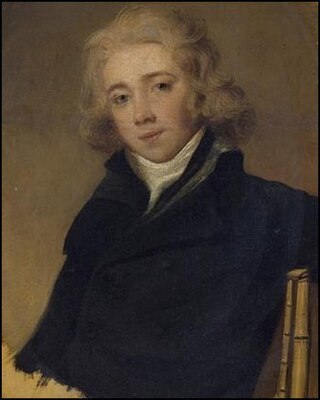Related Research Articles

The Piano Concerto in A minor, Op. 16, composed by Edvard Grieg in 1868, was the only concerto Grieg completed. It is one of his most popular works, and is among the most popular of the genre. Grieg, who was only 24 years old at the time of the composition, had taken inspiration from Robert Schumann's piano concerto (Op.54), also in A minor.

The Sanguine Fan, Op. 81, is a single-act ballet written by Edward Elgar in 1917. It was composed to raise money for wartime charities, and after two performances in 1917 and a recording of excerpts in 1920, the score was neglected until 1973, when the conductor Sir Adrian Boult revived it for a recording. It was later staged in the theatre by the London Festival Ballet.

Asger Hamerik (Hammerich) was a Danish composer of the late romantic period. Aged 80 at time of death.
Songs Without Words is a series of short lyrical piano works by the Romantic composer Felix Mendelssohn written between 1829 and 1845. His sister, Fanny Mendelssohn, and other composers also wrote pieces in the same genre.
Sergei Prokofiev's Quintet in G minor, Op. 39 is a piece of chamber music for oboe, clarinet, violin, viola and double bass, written in 1924. The quintet, closely related to Prokofiev's ballet, Trapèze, contains six movements and lasts 20–25 minutes.
Checkmate is a one act ballet created by the choreographer Ninette de Valois and composer Arthur Bliss. The idea for the ballet was proposed by Bliss, and subsequently produced by de Valois for the Vic-Wells Ballet. It was first performed on 15 June 1937 at the Théâtre des Champs-Élysées, Paris. Checkmate is widely regarded as de Valois' signature ballet and a cornerstone of the British ballet repertoire, being performed regularly by the Royal Ballet and Birmingham Royal Ballet.

Hyacinthe Jadin was a French composer who came from a musical family. His uncle Georges Jadin was a composer in Versailles and Paris, along with his father Jean Jadin, who had played bassoon for the French Royal Orchestra. He was one of five musical brothers, the best known of whom was Louis-Emmanuel Jadin.
Saint-Saëns' Cello Concerto No. 2 in D minor, Op. 119, is written in two movements, like his Fourth Piano Concerto. It was composed in 1902 and is dedicated to the Dutch cellist, Joseph Hollman, who gave the first performance on February 5, 1905 in Paris. The Second Concerto is much more virtuosic than the First, but does not possess the thematic inventiveness and harmonic intricacy of the First.
Franz Ries was a Romantic German violinist and composer, son of Hubert Ries. He studied at the Paris Conservatory. He also worked in the publishing business.

Edmund Thomas Chipp was an English organist and composer. His compositions were principally church organ music and oratorios.

Felix Mendelssohn's six Organ Sonatas, Opus 65, were published in 1845. Mendelssohn's biographer Eric Werner has written of them: "Next to Bach's works, Mendelssohn's Organ Sonatas belong to the required repertory of all organists."
Eight Improvisations on Hungarian Peasant Songs, Op. 20, Sz. 74, BB 83, also known as Improvisations on Hungarian Peasant Songs or simply as Improvisations, is a composition for solo piano by Hungarian composer Béla Bartók. It was finished in 1920.
Fifteen Hungarian Peasant Songs, Sz. 71, BB 79 is a collection of short folk melodies arranged for piano by the Hungarian composer Béla Bartók. It was composed between 1914 and 1918. In 1933, Bartók adapted and orchestrated parts of the piece as Hungarian Peasant Songs, Sz. 100, BB 107, commonly known by its Hungarian name, Magyar parasztdalok.
Trapèze is a ballet by Sergei Prokofiev. Closely related to his Quintet, Op. 39 (1924), it contains eight movements and lasts 20–25 minutes. The complete ballet in eight movements was first performed in Gotha, a German town near Hanover, on 6 November 1925.
The Sinfonía pirenaica, inspired by the Pyrenees, was composed by Jesús Guridi in 1945 and premiered on 8 February 1946 in Bilbao by the Bilbao Municipal Orchestra conducted by Jesús Arámbarri. Lasting c. 49 minutes, it consists of three movements:
- Andante sostenuto — Allegro molto moderato
- Presto ma non troppo
- Allegro brioso
The Violin Sonata in B minor, P 110, is a sonata for violin and piano by Italian composer Ottorino Respighi, completed in 1917. It is one of Respighi's major large-scale chamber works.
References
- ↑ Bliss A. Adam Zero – A Ballet. Piano Score. Novello, London, 1946.
- 1 2 Bliss A. Adam Zero – A Ballet. Piano Score. Novello, London, 1946.
- ↑ After a few performances Helpmann injured himself on stage and had to retire from the role. Burn A. Liner notes to Naxos CD 8.553460.
- ↑ Burn A. Liner notes to Naxos CD 8.553460.
- ↑ Stadttheater Bremerhaven website page about Adam Zero / Die vier Jahreszeiten Archived 2016-05-13 at the Wayback Machine accessed 26 April 2016.
- ↑ When the curtain rises and again at the very end, the stage is completely bare with a view of the back stage wall. Bliss A. Adam Zero – A Ballet. Piano Score. Novello, London, 1946.
- ↑ This section is prefaced by a quote from Shakespeare: "All the world’s a stage..." from As You Like It .